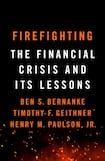
To conclude that the best part of this book is the slides of a presentation at the end of it sounds like the faintest of praise. The authors of Firefighting ensure otherwise.
Ben Bernanke, Timothy Geithner and Henry Paulson served at the epicentre of the global financial crisis. Bernanke served as chairman of the Federal Reserve, his fellow authors served as secretaries of the Treasury under presidents Bush and Obama.
Their collaboration now seems far removed. The authors’ respect for each other, and for Democratic and Republican policymakers, is a reminder of the value of bipartisanship.
This respect is not a luxury. In times of crisis, where political power is shared across institutions, it is a necessity.
The presentation, attached as an appendix, is striking. Data reminds the reader of the scale of economic catastrophe that commenced in 2007.
The greatest strength of this work is the candour on political dilemmas. It is brutally honest on questions of moral hazard; do governments and central banks “bail out” the very institutions that are responsible for disaster in order to avoid greater economic and human harm?
The conclusion is clear when we consider the fact that “the top priority in an epic crisis should always be to end it, even though that will likely create some moral hazard. The downsides of encouraging undisciplined risk taking in the future, while real, pale in comparison to the downsides of allowing a systemic collapse in the present”.

These choices are frequently made when information is incomplete, with intense media and political focus. Improvisation can become the norm, with the prospects of success and failure finely balanced.
The scale of these policy choices is reviewed. Making huge amounts of capital available to banks, providing funding for their daily operations, rescuing some banks and watching others fail. The chapters remind the reader of the scale of intervention, unprecedented both in terms of their controversy and economic impact.
Their conclusions are clear.
First, that “eventually, the full force of the US government proved to be enough to put out the fire, but just barely. Anything less would not have been enough”. Unprecedented intervention in the financial markets, combined with federal efforts to support the car industry and inject more demand into the American economy just about worked.
Second, that globally we might struggle with the next economic crisis. Governments are indebted, interest rates are already very low, some crisis time measures have now been taken off the statute book. The arsenal, the authors argue, is depleted. “When times are good, the dangers of backsliding can seem negligible” is the pithy conclusion.
But bigger questions are not posed in this book. Issues such as the highly financial nature of the global economy, and the balance between the market and state are barely acknowledged.
The human dimension does not get enough weight. That homes were lost, lives destroyed and prospects shattered is not sufficiently to the fore amid the impressively presented data and graphs.
Finally, the role of elected politicians is worryingly diminished. This should not be confused with lack of respect for their role by the authors. But it is politicians, alive to the need to maintain political consent, who have to make the public case for the most difficult decisions.
This is as it should be. If they do not, the seeds for the erosion of the legitimacy of regulation are sown.
The brevity of this book always made incompleteness of reflection on epic events likely. But there is still, just about, enough insight for this book to be a reminder of where we were and where we need to avoid in the future.
Paschal Donohoe is the Minister for Finance, Public Expenditure and Reform












